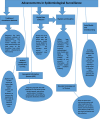Harnessing technology for infectious disease response in conflict zones: Challenges, innovations, and policy implications
- PMID: 38996110
- PMCID: PMC11245197
- DOI: 10.1097/MD.0000000000038834
Harnessing technology for infectious disease response in conflict zones: Challenges, innovations, and policy implications
Abstract
Epidemic outbreaks of infectious diseases in conflict zones are complex threats to public health and humanitarian activities that require creativity approaches of reducing their damage. This narrative review focuses on the technology intersection with infectious disease response in conflict zones, and complexity of healthcare infrastructure, population displacement, and security risks. This narrative review explores how conflict-related destruction is harmful towards healthcare systems and the impediments to disease surveillance and response activities. In this regards, the review also considered the contributions of technological innovations, such as the improvement of epidemiological surveillance, mobile health (mHealth) technologies, genomic sequencing, and surveillance technologies, in strengthening infectious disease management in conflict settings. Ethical issues related to data privacy, security and fairness are also covered. By advisement on policy that focuses on investment in surveillance systems, diagnostic capacity, capacity building, collaboration, and even ethical governance, stakeholders can leverage technology to enhance the response to infectious disease in conflict settings and, thus, protect the global health security. This review is full of information for researchers, policymakers, and practitioners who are dealing with the issues of infectious disease outbreaks in conflicts worn areas.
Copyright © 2024 the Author(s). Published by Wolters Kluwer Health, Inc.
Conflict of interest statement
The authors have no funding and conflicts of interest to disclose.
Figures





Similar articles
-
Perspectives of Australian policy-makers on the potential benefits and risks of technologically enhanced communicable disease surveillance - a modified Delphi survey.Health Res Policy Syst. 2019 Apr 4;17(1):35. doi: 10.1186/s12961-019-0440-3. Health Res Policy Syst. 2019. PMID: 30947721 Free PMC article.
-
The Sudan conflict: A catalyst for the spread of infectious diseases in displaced populations.Int J Infect Dis. 2025 Feb;151:107326. doi: 10.1016/j.ijid.2024.107326. Epub 2024 Dec 6. Int J Infect Dis. 2025. PMID: 39647578 Review.
-
Strengthening health security at the Hajj mass gatherings: characteristics of the infectious diseases surveillance systems operational during the 2015 Hajj.J Travel Med. 2017 May 1;24(3):taw087. doi: 10.1093/jtm/taw087. J Travel Med. 2017. PMID: 28355612 Free PMC article.
-
Intersecting realities: Exploring the nexus between armed conflicts in eastern Democratic Republic of the Congo and Global Health.One Health. 2024 Jul 3;19:100849. doi: 10.1016/j.onehlt.2024.100849. eCollection 2024 Dec. One Health. 2024. PMID: 39071485 Free PMC article.
-
Trends of major disease outbreaks in the African region, 2003-2007.East Afr J Public Health. 2010 Mar;7(1):20-9. doi: 10.4314/eajph.v7i1.64672. East Afr J Public Health. 2010. PMID: 21413568 Review.
Cited by
-
Sustainable development goals (SDGs) and resilient healthcare systems: Addressing medicine and public health challenges in conflict zones.Medicine (Baltimore). 2025 Feb 14;104(7):e41535. doi: 10.1097/MD.0000000000041535. Medicine (Baltimore). 2025. PMID: 39960902 Free PMC article. Review.
-
Medical gases and long-term oxygen therapy: reducing the chronic obstructive pulmonary disease burden in aging populations in Sub-Saharan Africa.Med Gas Res. 2026 Mar 1;16(1):46-52. doi: 10.4103/mgr.MEDGASRES-D-25-00024. Epub 2025 Jun 28. Med Gas Res. 2026. PMID: 40580188 Free PMC article. Review.
-
The role of digital health in pandemic preparedness and response: securing global health?Glob Health Action. 2024 Dec 31;17(1):2419694. doi: 10.1080/16549716.2024.2419694. Epub 2024 Oct 22. Glob Health Action. 2024. PMID: 39435565 Free PMC article. Review.
-
AI-driven biomarker discovery: enhancing precision in cancer diagnosis and prognosis.Discov Oncol. 2025 Mar 13;16(1):313. doi: 10.1007/s12672-025-02064-7. Discov Oncol. 2025. PMID: 40082367 Free PMC article.
-
Innovative technologies to address neglected tropical diseases in African settings with persistent sociopolitical instability.Nat Commun. 2024 Nov 27;15(1):10274. doi: 10.1038/s41467-024-54496-4. Nat Commun. 2024. PMID: 39604349 Free PMC article.
References
-
- Schmid B, Raju E. Humanitarian crisis and complex emergencies: burden of disease, response, and opportunities for global health. In: Handbook of global health. Cham: Springer International Publishing. 2021. pp. 2437–72.
-
- Lohrmann R. Migrants, refugees and insecurity. Current threats to peace? Int Migr. 2000;38:3–22. - PubMed
Publication types
MeSH terms
LinkOut - more resources
Full Text Sources
Medical

